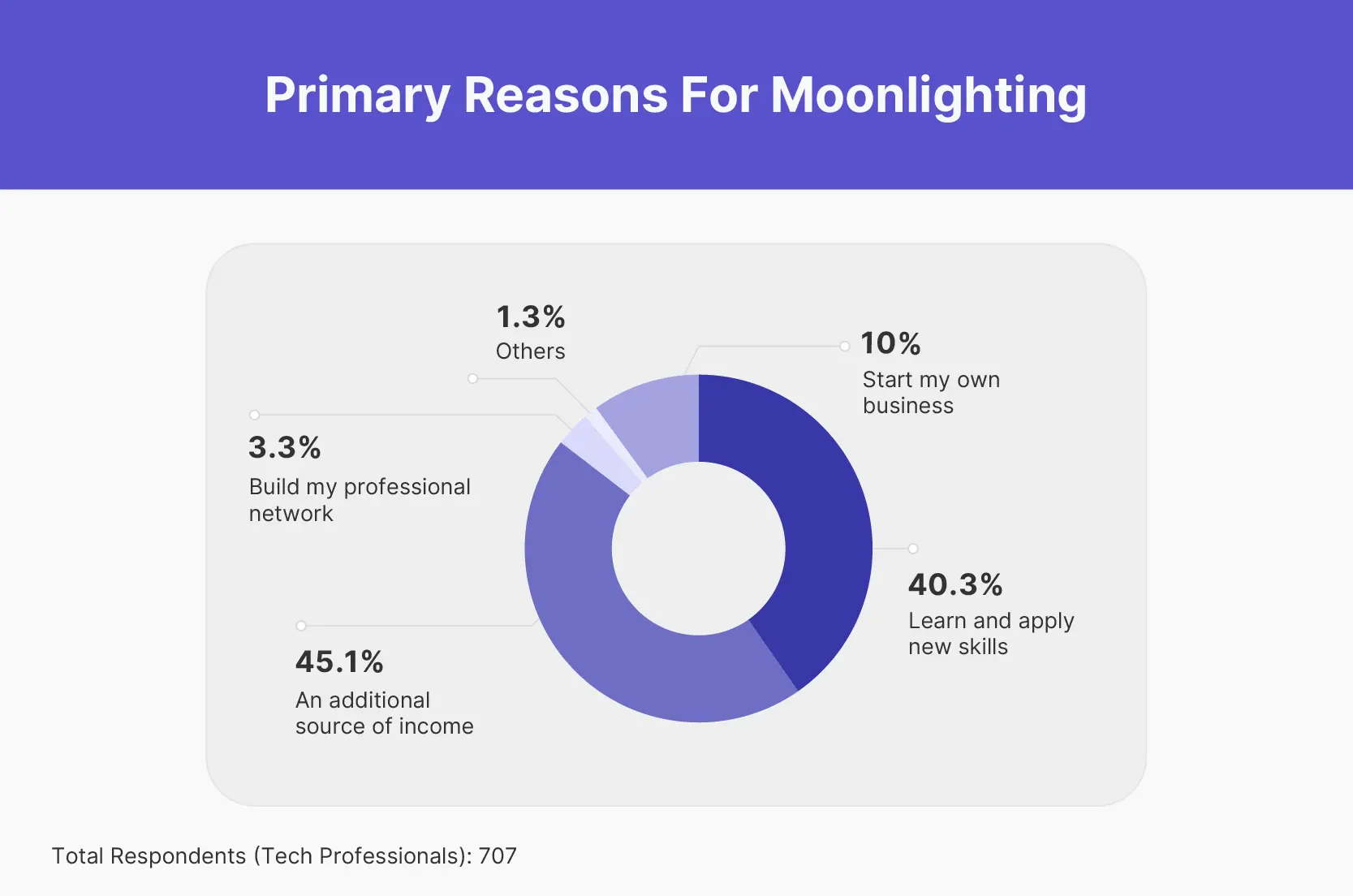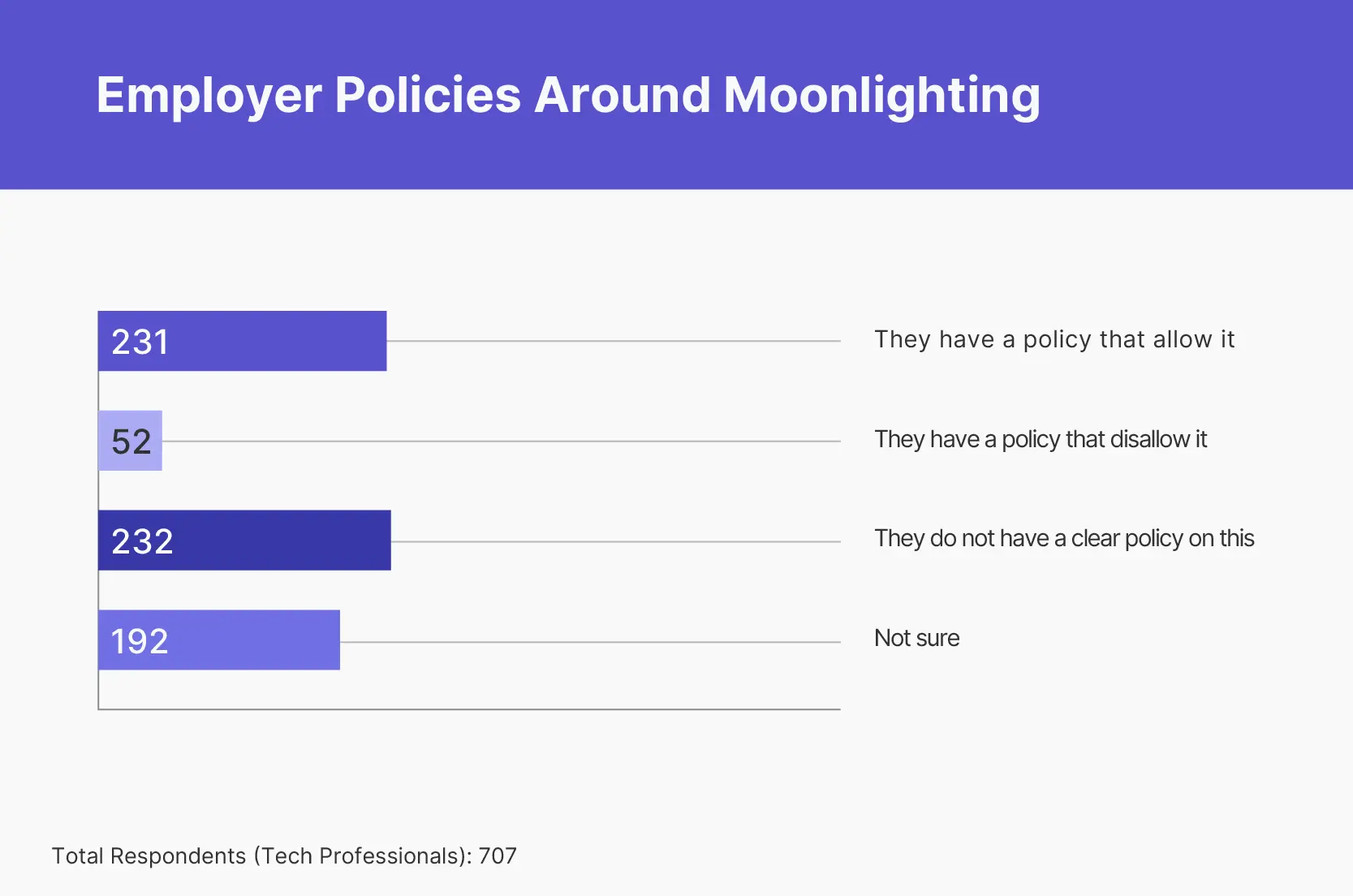Moonlighting In The Indian IT industry
Facts, Myths And The Way Forward

Executive Summary
Moonlighting, or working a second job or side gig in addition to one's primary employment, is a topic that has generated debate in recent times. Wipro CEO Rishad Premji called moonlighting ‘cheating and unacceptable’ with Wipro soon laying off over 300 employees who were ‘caught moonlighting’. Similarly, N. Chandrasekaran, the Chairman of Tata Sons said recently, "We actively discourage moonlighting because it can compromise the quality of work we deliver and pose a security risk."
Moonlighting Survey by Cutshort
Since Cutshort’s mission is to further career success for modern professionals, we conducted a survey to gain a deeper understanding of the experiences and attitudes of IT professionals towards moonlighting. The survey was completed by more than 3,000 tech professionals with a diverse range of work experience, including individuals with 0-1 years of experience, 1-3 years of experience, and those with 3-7 years of experience.
Key Findings
These were some key insights that were revealed by the survey:

Moonlighting is still not very common, with only 22.91% of respondents claimed to have moonlighted in the past or are currently moonlighting, and 7.36% currently moonlighting.

Moonlighting is more common in early career professionals for reasons such as learning and networking. While it is much lesser among people in 3-7 years of experience, it increases again between 7-10 years of experience, although for different reasons this time.

Employers’ concern that moonlighting affects productivity of employees at their day job is likely unfounded since 75% moonlighters claimed to be spending less than 10 hours a week on moonlighting, with 31% spending less than 4 hours a week.

Contrary to popular belief, the top reason for moonlighting was not earning money. Instead, it is ‘learning and applying new skills’ (chosen by 83.59% of those moonlighting) followed by ‘building a professional network’ (chosen by 52.89% of those moonlighting).
It is to be noted that most respondents were IT professionals who were either actively looking for new career opportunities or were working at not just large IT services/consulting firms but also smaller IT consulting companies as well as product startups and large product companies.
Way Forward
Later in the report, we cover the legal, ethical and other important aspects of moonlighting. We also cover how companies can address it. We encourage companies to frame their policies on moonlighting based on facts and reports that apply to their context. We urge them to not go by personal anecdotes and smaller sample sets that may paint an inaccurate picture.
Introduction

Moonlighting is the practice of taking up side hustles while you have a primary job. This phenomena has been the topic of discussion in various industries, especially tech.
- Wipro CEO Rishad Premji called moonlighting ‘cheating and unacceptable’. Wipro followed this official statement with the lay-off of over 300 employees who were moonlighting.
- N. Chandrasekaran, the Chairman of Tata Sons said, "We actively discourage moonlighting because it can compromise the quality of work we deliver and can be a security risk." TCS also said that while they will go easy on the moonlighting employees, they will not allow it.
- Infosys has asked employees to disclose and clarify any outside work they may be doing. As a result, many companies are now conducting background checks to ensure that potential hires are not already engaged in moonlighting.
- Even the IT minister of Karnataka has come out saying that this practice is ‘literally cheating.’
However, not everyone has a negative opinion of moonlighting.
- Rajeev Chandrasekhar, India’s Minister of State for Electronics and IT, supports this practice. He says that this era of Indian workforce has seen a structural shift in the attitudes of tech professionals.
- Even Tech Mahindra has supported moonlighting by saying that they may consider creating a policy that will allow employees to have other jobs as long as ‘someone is meeting the efficiency and productivity norms.’
However, despite the plethora of opinions offered by tech executives and fledgling entrepreneurs alike, the conversation lacks a deeper examination of the underlying complexities. Unfortunately, empirical research examining the psychological and practical motivations and challenges faced by those who do or do not engage in moonlighting is often elusive.
Survey And Methodology
At Cutshort, we aim to fill this gap of not having unbiased data on this subject.
We conducted a survey to gain a deeper understanding of the experiences and attitudes of tech professionals towards moonlighting. The survey results are both insightful and thought-provoking, affording us a revealing window into the current state of the sector. Our study sheds light on employees’ motivations for moonlighting, its pros and cons, effects on individual skill development, overall workforce attitude towards it, and much more.
Methodology
Our survey participants consisted of 3,000+ tech professionals, of which 707 were moonlighting or had previously moonlighted. The respondents came from a diverse range of work experience. Of the respondents who are or had moonlighted, 188 are just starting out with 0-1 years of experience, 229 had 1-3 years of experience, and 149 have been in the industry for 3-7 years. We also received 54 responses from participants with 7-10 years of experience and 61 responses from tech professionals with 10+ years of experience.
The survey had a completion rate of 54.7% and took an average of 2.5 minutes to complete, indicating that this topic is of interest to tech professionals of various levels and years of experience.
Key Insights On Moonlighting: What’s Real And What’s Hyped
The results gave us a glimpse into the current state of the professional market.

What percentage of the IT workforce is moonlighting?
There are several questions that the moonlighting discussion poses, the first one being, what percentage of the workforce is moonlighting? What percentage is sticking with it? And more importantly, is the number big enough to justify strong reactions of major corporations towards them?

Out of the 3085 tech professionals we surveyed, 707 (22.91%) claimed that they have either moonlighted in the past or are currently moonlighting. Among the 707 respondents, 227 respondents are currently moonlighting (Just 7.36% of total respondents).
Who Exactly Is Taking Up Side Hustles?
The survey showed that moonlighting is most common in the early career (0-3 years). Almost 31% of respondents with 0-1 years of experience were involved in moonlighting. Then, as the experience level increases, moonlighting gets less prevalent - it was lowest for individuals with 3-7 years of experience.

However, as the experience level crosses 7 years, there is a noticeable spike in moonlighting among workers with experience of 7-10 years and greater than 10 years.
What are the motivations for moonlighting and how do they change with work experience
The next mystery of the moonlighting discourse is understanding the motivations behind pursuing side hustles.
In theory, making extra money comes to the mind as the most obvious motivator for moonlighting. It seems like the most powerful reason why people would sacrifice their hard-earned free time to do another job. However, our study points in a few other directions.
In our survey, every individual who has moonlighted or is currently moonlighting was asked to select two reasons for taking up side hustles. One was chosen as the main reason and the next was chosen as an additional reason.


While earning an additional income was a popular answer for all experience levels with 45% of respondents choosing it as the “primary reason”, learning and applying new skills emerged as the other top reason for moonlighting with 73.41% of the respondents choosing it as either a primary or secondary reason.

Does moonlighting affect productivity at the primary job?
Compared to the survey responses, it seems that the reaction of the industry to moonlighting is a bit knee-jerk.

In the total pool of 707 respondents, close to 73.69% (521) respondents are spending less than 10 hours moonlighting per week. While 40% are spending less than 4 hours on moonlighting.
Combined with the fact that learning is one of the key motivators of moonlighting, it’s likely that this time spent on moonlighting would have been spent on other learning avenues if moonlighting was not an option. Hence, little time would have been saved if moonlighting was not available.
Now that we know what the moonlighting landscape looks like in India, let’s try to answer more pertinent questions that are nagging the minds of all tech recruiters and professionals.
State Of The Moonlighting Debate In The Indian IT industry And The Way Forward
Let’s look at the different perspectives about moonlighting and if there are any insights from this survey that can be relevant to them.
Legal and ethical issues
The discussion around moonlighting so far has been majorly dichotomous in the tech sector. One faction of tech leaders says that moonlighting is wrong. Rishad Premji says, “Moonlighting is cheating, plain and simple.”
However, very few prominent business leaders have stepped forward to back up the controversial practice.
- For instance, Krish Gopalakrishnan, the Co-Founder of Infosys said, with respect to moonlighting, “As long as it doesn't interfere with the employee's performance or the interests of the company, we don't see it as a problem.”
- Taking a more balanced approach with supporting the practice, Shailendra Singh, the Managing Director of Sequoia Capital India & SEA said, “It's a free country and people have the right to do what they want in their free time, but they should not use company resources, time or intellectual property for personal gains.”
The Cutshort View
There is no clear law that makes moonlighting illegal in India. There are no specific laws that prohibit individuals from holding more than one job, as long as they fulfill their responsibilities and obligations in each job.
However, some companies may have policies in place that regulate or prohibit their employees from moonlighting, especially if it interferes with their primary job responsibilities.
It is important for individuals to check with their primary employer and understand any policies or restrictions before starting a second job. Additionally, they should ensure that they comply with tax laws and regulations related to multiple sources of income.
Decrease in employee productivity as employees spend too much time on the side hustle
Loss of employer productivity is the most common concern shared by the companies.
Rajan Anandan, said (when he was Managing Director of Google India), “We don’t have a policy against moonlighting, but we do expect our employees to put their primary job first and ensure that their side projects do not conflict with the interests of the company.”
The Cutshort View
Our study shows that this concern may be based more on anecdotal evidence, and not on concrete research. In our survey, 73.69% of moonlighters say that they spend less than 10 hours per week on moonlighting with 4-10 hours being the most popular range amongst respondents. That comes down to less than 1 hour per day per week, which is less than the time employees spend on lunch breaks and office travel.
Further, among the respondents who are spending more than 10 hours moonlighting (187), 158 (84.49%) of them had learning and applying new skills as a motivation to moonlight and only 73 (39.03%) had additional income as a motivation. This suggests that if these individuals do not moonlight, they will engage in other skill-building activities such as taking courses or attending workshops.
Conflict of interest arising from an employee working for a competitor
Although it’s typical for companies to have a clause in the employee agreement that prevents the employee from working with a competitor, whether this clause will be upheld by the courts in India is not so straightforward.
But employees working for rival companies is definitely a big concern for companies. This was the reason why Wipro had fired nearly 300 employees ‘as they chose to take up a second job with rival firms while being on the payroll of Wipro’. Wipro call this ‘cheating - plain and simple.’
The Cutshort View
IT companies, especially product companies and startups, thrive on product or process innovations. An employee often has access to a lot of confidential information and trade secrets, which if leaked to competitors can bring significant short and long term damages to the company.
What is a trade secret? What is safe to share and what can lead to ethical and legal issues? This can be difficult to judge for anyone. Hence, it’s best for moonlighting employees to avoid working with a direct competitor of their primary employer.
Misuse of company resources and data breaches
Employees may sometimes use company provided devices and resources to perform side jobs. This not only puts the employee in an ethical gray area, but also makes company data vulnerable to breaches and leaks.
The Cutshort View
It’s important for moonlighters to understand the ethical and legal obligations to ensure data security for their primary employers.
Moonlighters should keep a clear separation between the resources, devices and data of their primary employers and their moonlighting projects. This is easier said than done though. In an increasingly interlinked world of browsers, devices, cloud storage services like Google Drive, this separation is not always “physical” and needs careful planning on the part of moonlighters. Keeping separate devices, separate browsers, account credentials, storage accounts, etc. are some good starting points.
What Moonlighting Means For Tech Companies
Given the recent hot debates on moonlighting, we thought it would be good to know how the industry has formally reacted to it, so far.
In our study, 32.67% of the 707 moonlighters said that their companies allow moonlighting while a similar proportion of respondents said that their company does not have a clear policy for moonlighting.

Almost 60% of respondents said they are either not sure about their company’s policy on moonlighting (27.16%) or their company does not have a clear policy on moonlighting (32.81%).
The Need Of Making A Moonlighting Policy At Your Company And How To Go About It*
*This is not a legal opinion. Please consult your legal advisor.
The data presented above indicates a huge lack of clarity on both sides - employers’ and employees’.
Hence, the most obvious (and currently accepted) solution to the moonlighting problem is for primary employers to introduce a detailed moonlighting policy. The employer needs to be clear on what they expect from their employees and set out guidelines that will help keep things above board.
Additionally, employers should provide education about conflict of interest policies regarding company confidential information so that employees understand what they can and cannot do while moonlighting.
We know that developing a moonlighting policy and effectively communicating it with employees can safeguard an organization against most challenges that arise due to dual employment. However, making that policy and complying with it is not always easy, especially for large businesses. So here are a few touchpoints you can start with while introducing or modifying your policy.

Assess the company's needs and goals
Determine the purpose and objectives of the policy and how it aligns with the company's overall goals and values.

Review relevant laws and regulations
Ensure that the policy complies with all relevant employment laws and regulations, including those related to overtime, fair labor practices, and tax obligations.

Define moonlighting
Clearly define what is considered moonlighting and the types of secondary employment that are permitted or prohibited.

Establish reporting requirements
Require employees to report any secondary employment to the company, including the type of work, the employer, and the number of hours worked.

Address conflicts of interest
Outline how conflicts of interest will be handled, such as prohibiting secondary employment that is in direct competition with the company or that requires the use of confidential information.

Consider the impact on performance
Consider the potential impact that moonlighting may have on an employee's performance, health, and well-being, and establish guidelines for managing these risks.
What the Future Might Hold
Moonlighting is becoming more prevalent in the tech industry, driven by factors such as the high demand for tech talent, increase in remote work opportunities, and the rise of the gig economy. Companies are faced with the challenge of managing moonlighting in a way that balances the needs and interests of both the employees and the organization.

Technological advancements
Technological advancements may create new opportunities for moonlighting, such as online platforms and tools that make it easier for employees to find and apply for secondary jobs.

Changes in employment laws
Changes in employment laws and regulations may impact the moonlighting industry, such as laws related to overtime pay, tax obligations, and worker classification.

Increased awareness
Companies are likely to become more aware of moonlighting and its potential impact on their operations and employees. Some companies may choose to restrict or prohibit moonlighting, while others may adopt more flexible policies that encourage it.

Continued growth
The moonlighting industry is likely to continue to grow, driven by factors such as the increasing demand for skilled workers, the rise of the gig economy, and the trend towards remote work.
Our research also shows that if candidates have spent a higher number of years working for the same company, they are less likely to moonlight. This means that a new and younger workforce is more likely to moonlight. The technology sector in India has lately reported an increase in turnover rates due to high demand for skilled workers and the availability of alternative employment opportunities. This might also point to a possible increase in moonlighting.
Conclusion

Moonlighting is an evolving trend in India, especially post COVID. With the recent growth in the popularity of work-from-home jobs and start-up culture, this concept may receive stronger support in the future. That said, the legality depends on the company’s policy, the nature of employment, and other factors involved in a work environment.
We hope this report helped you separate the real facts from hypothetical or anecdotal assumptions.
In a fast changing professional world of today, it’s important to understand the needs and motivations of employees and marry them with the needs of your company to find the right solution that leads to success of all the stakeholders.
